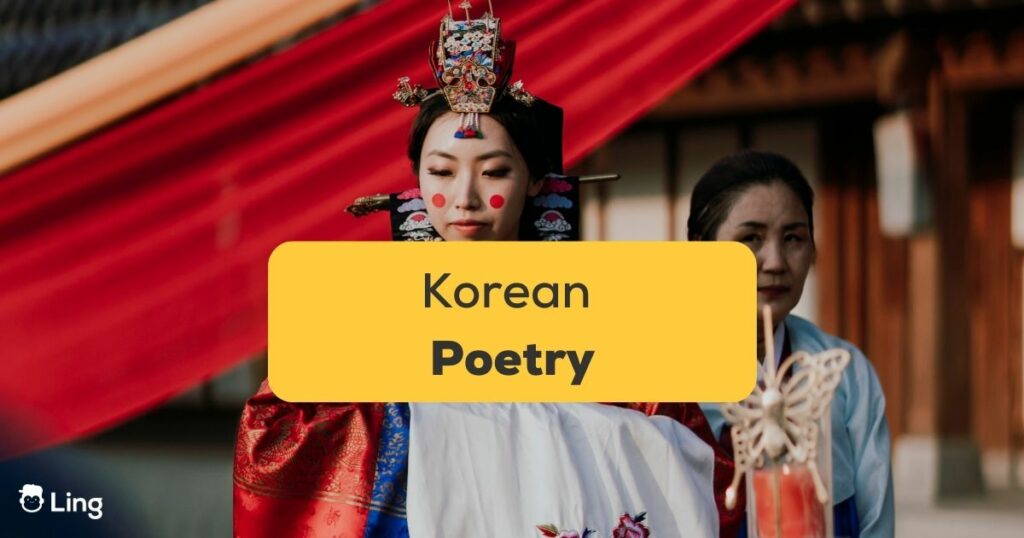Korean poetry is a magnificent tapestry that has been intricately woven into the cultural fabric of Korea for centuries. The threads of its literature and its rich and fascinating history stretching back to the Three Kingdoms period, a time when poets first began to capture the beauty and essence of their world in verse. Since then, poetry has become an essential part of Korean literature and art, serving as a reflection of Korean society’s values, beliefs, and traditions.
Through the centuries, Korean poetry has been a versatile and expressive medium, used to convey personal emotions, celebrate cultural events, and offer social commentary. It has been a source of comfort and inspiration to generations of Koreans, serving as a means of understanding the complexities of the world around them.
In this article, we will embark on a journey through the history of Korean poetry, tracing its roots and exploring its evolution into modern times. We will also delve into the importance of Korean poetry in Korean culture, examining its influence on society and the role it has played in shaping Korean identity. Furthermore, we will examine the impact of the translation of Korean poetry on other cultures and its place in the wider literary world, revealing the enduring legacy of this exquisite art form.
Korean poetry is an art form that has stood the test of time, captivating audiences for centuries with its unique style and structure.
Traditional Korean Poetry

The three traditional forms of Korean poetry, sijo, gasa, and hyangga, have distinct characteristics that set them apart and make them a fascinating representation of Korean culture and history.
Sijo, with its concise three-line structure, is a poetic form that can pack a powerful emotional punch. The 44-46 syllable count and its lyrical quality provide an expressive medium for the poet to convey a range of emotions, from joy and longing to sadness and regret. Yun Seondo’s sijo about the moon and the cherry tree blooming on the moonlit night is a prime example of how this form can convey a sense of nostalgia and a longing for the past.
Gasa, on the other hand, is a longer form of poetry that often tells a story. With elements of folklore, mythology, fiction, and history, gasa provides an engaging narrative that draws readers in. The literary devices used, including repetition, metaphor, and symbolism, make this form of poetry rich and multi-layered. Jeong Cheol’s gasa about a solitary figure waiting for the dawn to break is a moving reflection on the sorrow and heaviness of the world.
Hyangga, the oldest form of Korean poetry, uses local dialects and expressions to convey religious or philosophical themes. The 7-9-9-7 syllable structure and the repetition and alliteration are used to make this form of poetry memorable and evocative. Choe Chiwon’s Hyangga song about the pine tree growing along the mountain path and the clear stream flowing beneath its branches provides a serene image that speaks to a sense of peace and harmony.
Traditional Korean poetry forms offer a fascinating glimpse into Korean culture and history. Sijo, gasa, and hyangga each have unique qualities that make them valuable and enriching art forms. Whether it’s the expressive and lyrical sijo, the narrative and engaging gasa poems, or the philosophical and serene hyangga, Korean poetry provides a glimpse into the heart and soul of Korea.
Modern Korean Poetry
Modern Korean poetry is a treasure trove of creativity and expression. It emerged at a time of great social and political upheaval in Korea, as modernization, industrialization, and westernization swept through the country, bringing with them a new wave of artistic expression. Poets during this time began experimenting with new forms and styles, exploring themes that ranged from social and political to personal and emotional.
Social and political issues have been a major theme in modern Korean poetry. These poets have addressed the various issues that plague their country, including colonialism, dictatorship, and social injustice against women. They have used their works to critique the government and advocate for social change, often serving as the voice of the voiceless.
Nature and beauty have also been prominent themes in modern Korean poetry. Many poets have drawn inspiration from the natural landscape of Korea, with its majestic mountains, winding rivers, and lush forests. They have used nature as a vehicle to explore themes of spirituality, life, and death, often infusing their works with a sense of wonder and awe.
Personal experiences and emotions are also key themes in modern Korean poetry. Poets have used their works to express their own thoughts, feelings, and experiences, exploring themes of love, war, loss, and identity. Through their words, they have brought to life the human experience, capturing the joys and sorrows of life with raw and honest beauty.
Ko Un, Yi Sang, and Kim Hyesoon are just a few of the many modern Korean poets and writers who have left their mark on the literary world. Each has a unique style and voice, exploring themes that are both universal and deeply personal. Their works serve as a testament to the power of poetry to capture the complexities of the human experience, and to bring to light the issues and ideas that shape our world.
Overall, modern Korean poetry is a vibrant and diverse art form that continues to evolve and thrive. Through its exploration of social and political issues, nature and beauty, and personal experiences and emotions, it offers a window into the rich culture and history of Korea, and a glimpse of the universal truths that connect us all.
Examples
| Korean Poetic Verses | Korean Romanization | English Translation |
| 수부룩이 내려오는 눈발속에서는 | Subulug-i naelyeooneun nunbalsog-eseoneun | In the drizzling snow, |
| 목에 하얀 수건을 둘러놓고 얼굴을 씻겨주던 | Mog-e hayan sugeon-eul dulleonohgo eolgul-eul ssisgyeojudeon | He wrapped a white towel around his neck and washed his face. |
| 꽃잎 되어서 날아가 버린다. | Kkoch-ip doeeoseo nal-aga beolinda. | It turns into petals and flies away. |
| 해와 하늘 빛이, 문둥이는 서러워 | Haewa haneul bich-i, mundung-ineun seoleowo | The sun and the light of the sky, lepers are sad |
| 내가 그의 이름을 불러 주기 전에는 | Naega geuui ileum-eul bulleo jugi jeon-eneun | Until I called his name |
| 어린 눈발들이, 다른 데도 아니고 | Eolin nunbaldeul-i, daleun dedo anigo | Little snowflakes, nowhere else |
| 더욱 깊은 고요를 위하여 몸을 뒤채인다. | Deoug gip-eun goyoleul wihayeo mom-eul dwichaeinda. | Turn over for a deeper stillness. |
| 눈길 위로 사각의 서류 봉투가 떨어진다, 허리를 나는 굽히다말고 | Nungil wilo sagag-ui seolyu bongtuga tteol-eojinda, heolileul naneun gubhidamalgo | A square briefcase falls on the snowy road, I don’t bend over |
| 산골로 가는 것은 세상한테 지는 것이 아니다 | Sangollo ganeun geos-eun sesanghante jineun geos-i anida | Going to the mountain is not losing to the world |
Wrapping Up

Now you are on your way to becoming a Korean poet. If you want to write and speak Korean like a pro, then Ling App is what you need. It’s a great app to start learning any new language in no time.
And if you want to delve deeper into the fascinating facts and customs of this ancient civilization, where better to turn than Ling? This language-learning app is the ultimate destination for anyone looking to expand their knowledge of Korea and its rich cultural heritage.
But let me tell you, Ling is no ordinary language-learning app. With its incredible range of features and options, it’s the perfect tool to make your journey of learning Korean not just easy, but downright enjoyable. From interactive quizzes to engaging exercises, Ling has it all. And the best part? You won’t find such amazing options on any other language-learning app.
So why wait? If you’re ready to take your Korean learning experience to the next level, then Ling is the only destination you need. With its fun and easy-to-use interface, you’ll be speaking like a native in no time. So go ahead, download Ling today from the Play Store or App Store, and get ready to embark on the adventure of a lifetime!
If you want to learn more, check out our how to make Korean words plural and Korean grammar system articles here on the blog.




















